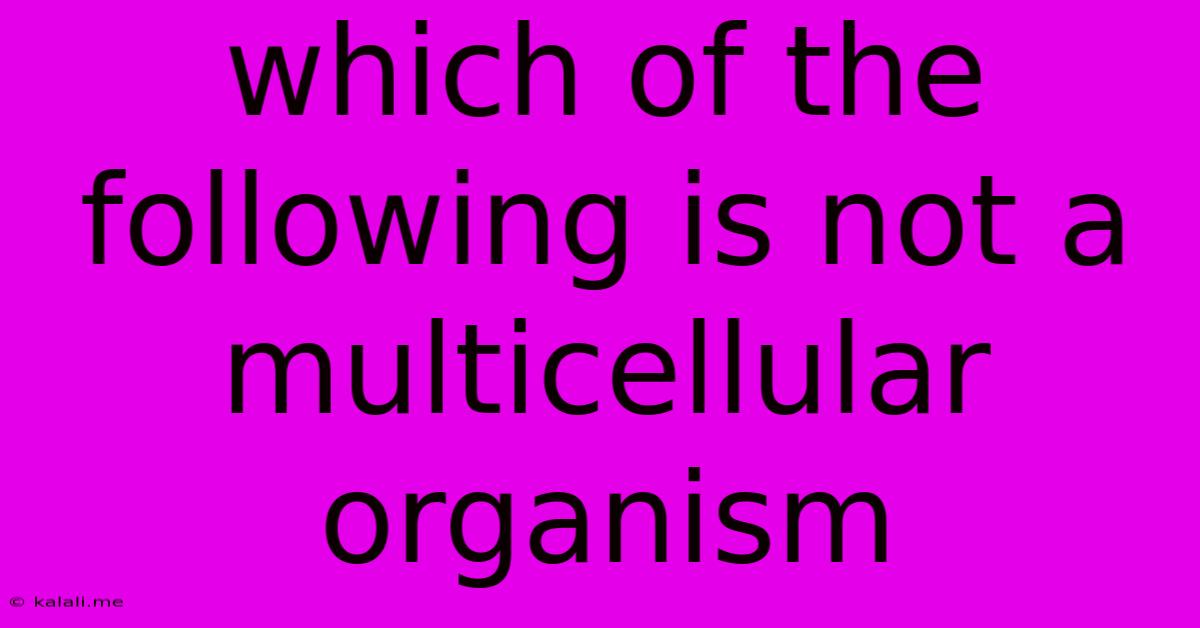Which Of The Following Is Not A Multicellular Organism
Kalali
Jun 13, 2025 · 2 min read

Table of Contents
Which of the Following is NOT a Multicellular Organism? Understanding Cellular Organization
This article explores the fascinating world of cellular organization, differentiating between unicellular and multicellular organisms. We'll delve into what defines multicellularity and examine examples to solidify your understanding. Understanding this fundamental biological concept is key to appreciating the diversity of life on Earth.
What is a Multicellular Organism?
A multicellular organism, as the name suggests, is an organism composed of more than one cell. These cells work together, often specializing in different functions, to form tissues, organs, and organ systems that contribute to the overall functioning of the organism. Examples of multicellular organisms are abundant and include:
- Animals: From microscopic invertebrates like tardigrades to massive blue whales, animals exhibit a remarkable range of multicellular complexity.
- Plants: From towering redwood trees to tiny flowering plants, plants showcase diverse multicellular structures adapted to their environments.
- Fungi: Mushrooms, molds, and yeasts (mostly) represent a diverse kingdom of multicellular organisms, although some fungi exist as single cells.
What is a Unicellular Organism?
In contrast, a unicellular organism, also known as a single-celled organism, is an organism consisting of only one cell. This single cell carries out all the necessary life functions, including reproduction, nutrient acquisition, and waste removal. Examples include:
- Bacteria: Prokaryotic single-celled organisms found virtually everywhere on Earth.
- Archaea: Another group of prokaryotic single-celled organisms often found in extreme environments.
- Protists: A diverse group of eukaryotic single-celled organisms, including amoebas and paramecia.
Identifying the Non-Multicellular Organism
Now, let's address the core question: identifying which organism from a given list is not multicellular. To correctly answer this, you need to carefully examine the characteristics of each organism presented. The key is to determine if the organism is composed of multiple cells working together or a single cell performing all life functions.
For instance, if a multiple-choice question presents options such as a human, an oak tree, an amoeba, and a mushroom, the correct answer would be the amoeba. Amoebas are single-celled protists and, therefore, not multicellular.
Understanding the Importance of Cellular Organization
The distinction between unicellular and multicellular organisms highlights the incredible diversity of life and the evolutionary adaptations that have allowed organisms to thrive in a wide range of environments. Multicellularity enabled the evolution of complex body plans and specialized functions, leading to the remarkable complexity we see in animals and plants. Studying this distinction provides crucial insights into the fundamental principles of biology and evolution.
Conclusion
In conclusion, determining whether an organism is unicellular or multicellular requires careful consideration of its cellular structure and function. By understanding the defining characteristics of each type of organism, you can accurately identify which organism from a given list is not a multicellular organism. This knowledge forms a cornerstone of understanding the breadth and depth of life on Earth.
Latest Posts
Latest Posts
-
Energy Stored In The Bonds Between Atoms Is Called
Jun 14, 2025
-
Which Statement About Cells Is True
Jun 14, 2025
-
Greatest Common Factor Of 56 And 84
Jun 14, 2025
-
Clutch Pack Limited Slip Differential Diagram
Jun 14, 2025
-
Average Gpa At University Of Toronto
Jun 14, 2025
Related Post
Thank you for visiting our website which covers about Which Of The Following Is Not A Multicellular Organism . We hope the information provided has been useful to you. Feel free to contact us if you have any questions or need further assistance. See you next time and don't miss to bookmark.